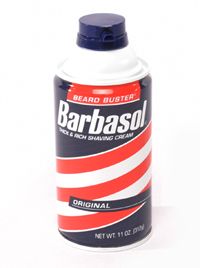Shaving Cream
Have you ever looked at shaving cream after it comes out of the can? This is lather. The foam is almost structural in its density and strength. Kids love playing with it because it is very nearly moldable, like a very lightweight foamed plastic. It is nothing like the lather than you get from soap. So where does this kind of foam come from?
You can read all about the aerosol can in How Aerosol Cans Work. But neither the can nor the delivery system is the reason why this foam is so cool. The foam is made by the chemicals in the can.
Advertisement
According to How Products Are Made, all shaving creams contain the same basic ingredients:
The combination of the glycerine, lanoline, Stearic acid and triethanolamine gives shaving cream its extra-creamy and dense lather. That combined with the propellant (often butane or propane) expands and instantly evaporates when it leaves the can, filling the foam with its millions of bubbles.
Shaving is obviously a big deal, and billions of people do it every morning. To learn lots more about shaving, check out the links below.
Related HowStuffWorks Articles
More Great Links
Sources
- Bennett, Ralph Kinney. "Razor Wars and the Cutting Edge of Technology." TCS Daily, October 11, 2005. http://www.tcsdaily.com/article.aspx?id=101105B
- Berlow, Lawrence H. "Shaving Cream." eNotes.com. http://science.enotes.com/how-products-encyclopedia/shaving-cream
- Blachford, Stacey L. and Bonny P. McClain. "Epilation Device." eNotes.com. http://science.enotes.com/how-products-encyclopedia/epilation-device
- "The Cutting Edge." The Economist, March 16, 2006. http://www.economist.com/science/displaystory.cfm?story_id=5624861
- "Design and Make a Homesteader's Knife." Country Skills, April/May 1996. http://www.motherearthnews.com/printable/1996_April_May/Design_and_Make_a_Homesteader_s_Knife
- Frommelt, Jon and Frances Mereda. "Recommendation for Razor Technology Improvements." May 8, 2000. http://web.mit.edu/3.52/RazorBlades.pdf
- Ganesan, Senthil. "Gillette: Managing Product Information." ICFAI Knowledge Center, 2003. http://www.ikc.icfai.org/casestudies/bestselling/Gillette.pdf
- Gillette: Fusion http://www.gillettefusion.com/us/
- Greenberg, Corey. "How to Get the Perfect Shave." Weekend Today, MSNBC.com, January 30, 2005. http://www.msnbc.msn.com/id/6886845/
- "How An Electric Razor Works." PageWise, 2005. http://www.pagewise.com/guides/shaving-electric-razor.htm/
- Krumholtz, Philip L. "Col. Jacob Schick." 1987. http://iavbbs.com/gflinn/schick.htm
- Mansfield, Howard. "The Razor King." AmericanHeritage.com, Spring 1992. http://www.americanheritage.com/articles/magazine/it/1992/4/1992_4_40.shtml
- Patent 775134. U.S. Patent Office. http://patimg1.uspto.gov/.piw?docid=US000775134&SectionNum=2&IDKey=E6DA24974FE1&HomeUrl=http://patft1.uspto.gov/netacgi/nph-Parser? Sect1=PTO2%2526Sect2=HITOFF%2526p=1%2526u=%25252Fnetahtml%25252FPTO%25252Fsearch-bool.html% 2526r=1%2526f=G%2526l=50%2526co1=AND%2526d=PALL%2526s1=0775134.PN.%2526OS=PN/0775134%2526RS=PN/0775134
- Razor Central http://www.en.nassrasur.com/razorcentral/index.html
- "Razor Sharpening And Using Tips." The KnifeCenter, 2004. http://www.knifecenter.com/knifecenter/sharpen/instrazor.html
- Roberts, Charles. "Wet Shaving Systematics: A Primer on the Roberts Method of Wet Shaving (RMWS)." 2006. http://www.enchanteonline.com/pages/faqs/primerfinal.pdf
- "Safety Razor." How Products Are Made, 2006. http://www.madehow.com/Volume-5/Safety-Razor.html
- Sampathkumar, K. "All India Status Report on Safety Razor Blades Industry." Small Industry Services Institute, 2004. http://www.smallindustryindia.com/publications/traderep/razorblades.pdf?GXHC_GX_jst=5a6d7079662d6164&GXHC_gx_session_id_=3ee2e691161a3f78&
- "The Shaving Historical Timeline." QuikShave. http://www.quikshave.com/timeline.htm
- Taylor, Rod. "The Cutting Edge." Promo Magazine, April 1, 2005. http://promomagazine.com/incentives/marketing_cutting_edge_2/
